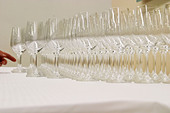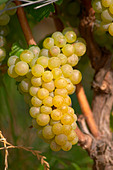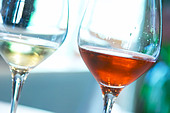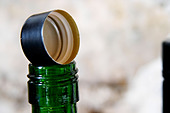Castilla y Léon
Castilla y Léon? Yes, that’s right. We were recently there to take a closer look at their wines, but not, as you might think their most famous wine region the Ribera del Duero. Let’s begin with a short intro: Castilla y Léon is one of the regions in Spain. It’s the biggest one and stretches from a bit north west of Madrid up to Galicia (bordering the Atlantic). On the western side it also touches Portugal. The main city is Valladolid, a charming mid-size city with direct flights to a few other European countries. Or you can fly to Madrid and take the train (or a car).
The region has about a dozen different wine districts, but we “only” had time to cover six of them over the three and a half days we spent there: DO Cigales, DO Arribes, DO Tierra del Vino de Zamora, VCPRD Valles de Benavente, DO Bierzo, DO Tierra de Leon. Here are some short notes:
Bodegas Concejo (previously Bodegas y Vinedos Pilcar) is a familiy vineyard with high ambitions, located in the DO Cigales close to Valladolid. Enrique Concejo runs the winery since a few years back when he took over after his father. Very modern wines with lots of barrel aging. He also has an impressive hotel project in the pipe, which seems to include renovating half of an ancient village nearby. www.concejobodegas.com
La Setera is a very small winery in the remote corner called DO Arribes (the district is actually called Arribes del Duero, but the DO is just Arribes. Apparently some tricky issue with DO Ribera del Duero…). The country side looks rough, remote and grandiose. La Setera makes the red wines primarily from a local grape variety called Juan Garcia, very interesting, producing wines with lots of freshness, acidity and minerality (good structure). They also make a white from malvasia that is a steal. A pity they make so few bottles. And on top of it they make wonderful goat cheese. www.lasetera.com
Bodegas Vinas del Cenit (DO aptly named Tierra del Vino de Zamora) is much bigger and a “commercial” oriented bodega (not least thanks to its site). They make very concentrated wines with lots of very ripe fruit and extensive barrel aging. Very modern and international in style. Curios fact: they have a vineyard with old ungrafted tempranillo. www.bodegascenit.com
Bodegas Viñas Zamoranas (DO Tierra Del Vino De Zamora). You cannot avoid talkling about the hotel that is part of the property when you describe Zamoranas. A very peculiar hotel experience. It’s in what used to be a priest seminary and decorated with a lot of religious and other ancient (and not so ancient) art. But don’t get it wrong – they also have an Egyptian night club! The wines are traditional and definitely not as bizarre as the hotel. www.hotel-convento.com
Bodegas Otero (V.C.P.R.D. Valles De Benavente) is on one of the big avenues in the town of Benavente (when the bodega was built it was in the countryside). Tasted several of their wines made from primarily the unusual grape variety prieto picudo (sometimes mixed with tempranillo). Good wines with a refreshing acidity and red fruit character. With aging potential, judging from the rosé 1970 we tasted! www.bodegasotero.es
Bodegas y Vinedos Agribergidum (DO Bierzo). Bierzo is in the far north west corner. Near the city of Ponferrada there is an old roman gold mine (Las Medulas). From the top of the mountain you have a spectacular view of what looks like gigantic termite mounds, but it’s what remains of the Unesco World Heritage classified mine. The bodega make excellent wines using varying brands for the different cuvees, both red, white, rosé and sparkling, modern in style without being over-dosed on oak. Will be interesting to follow their evolution. www.agribergidum.es
Bodegas Margon (DO Tierra de Léon) is a brand new vineyard. The owners are not short of resources so all equipment and the winery is gleaming new. The wines show nicely and promise well for the future. Perhaps a bit “international” so let’s hope they will try and develop the local originality once they have reached cruising speed. they do have one big problem: the wine is called Pricum, no doubt as a roman reference, but it will hardly work well as a brand in English speaking markets. www.bodegasmargon.com
Bodegas Frutos Villar, in DO Cigales, is the DO’s biggest producer. Their main brand in Cigales is Calderona. (They also own vineyards in Ribera, Rueda and Toro). They offer a wide range of products Calderona and others. Their mid range is the most interesting from a value for money standpoint (e.g. Roble and Crinaza). www.bodegasfrutosvillar.com
In other words, lots of things to see and taste in Castilla y Léon! Wine, Serrano ham in droves (yummy!), tapas and much more. We will have reasons to come back to this in other contexts.
Bordeaux Primeurs
This year’s primeur campaign is over. It turned out better than many had feared at early this year even if attendance was a bit down from last year. Now we have to wait and see what will happen to the prices, which will start coming out over the next few weeks and months. Only one chateau has already “come out” as we write this. Read more below.
Languedoc
Languedoc too has its Primeurs Launch. It was a multi-day event earlier this spring where participants had the opportunity to taste more than 500 wines from most of the regions appellations. It is difficult to give a brief summary of the wines (there were so many and of so different character), but they all seem to have turned out better than what could have been feared last summer. Before and during the harvest weather was nice but with cool nights, which has brought a fresh acidity and more aromas to the wines. We will come back to this!
Wine travel
Don’t forget to take a look at our travel program for this autumn further down in the Brief. We’re just back from a wonderful trip to Champagne and Chablis with four days of splendid weather. No dining outside yet but many wines were tasted in the vignerons’ gardens inn the spring sunshine.
The coming autumn we have two Bordeaux trips on the public schedule. But we also do custom made trips for wine clubs, private parties, companies and others. Last year we organised and personally led some 30 wine tours: France of course, but also Italy, Portugal, Spain, Germany, Austria, Germany…
Britt & Per
PS: Recommend to your friends to read the Brief or forward it to them !
More on wine:
Read all of this issue of the Brief here!
Read more...
 Consumption of wine in 2008 shrunk with 2 million hl, but the world wine market is becoming increasingly global. 37% of all wine produced were exported, i.e. were drunk in another country than where it was made. That’s up from 18% in the early 80s. World wine consumption is estimated to have reached 242,.9 Mhl in 2008, which is 2 Mhl less than in 2007. Ironically, it is primarily the big wine producing countries that have seen the consumption fall. In the “EU-15” people drank 2.2 Mhl less. It’s the first time in several years that wine consumption falls. (Source: OIV)
Consumption of wine in 2008 shrunk with 2 million hl, but the world wine market is becoming increasingly global. 37% of all wine produced were exported, i.e. were drunk in another country than where it was made. That’s up from 18% in the early 80s. World wine consumption is estimated to have reached 242,.9 Mhl in 2008, which is 2 Mhl less than in 2007. Ironically, it is primarily the big wine producing countries that have seen the consumption fall. In the “EU-15” people drank 2.2 Mhl less. It’s the first time in several years that wine consumption falls. (Source: OIV)














































